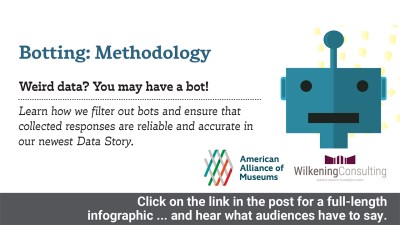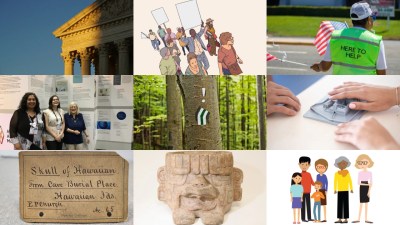
This visual Data Story is based on findings from the 2024 Annual Survey of Museum-Goers, a national survey of American museum visitors from AAM and Wilkening Consulting. Every year, the survey partners with individual museums to research their audiences and yield insights about their behaviors and preferences, both on an institutional and national level. Interested in joining the 2025 edition on the themes of repeat visitation, social connection, and community trust and responsibility? Sign up by February 28, 2025, for a special early bird rate.

Skip over related stories to continue reading article“Simply being out in the world … there’s so much to notice and experience that just gets passed by (or entirely lost) … Seeing new animals, plants, or even a shooting star when out at night, can all contribute to imagination and inspiration. People need wonder in their lives; otherwise, it’s too easy to become rigid and fearful of others and any kind of change.”
Fostering imaginative experiences is at the core of what many museums do. Imagination is tightly linked with creativity, innovation, and understanding different points of view or experiences (past, present, and future).
Virtually all museum-goers are open to the imaginative experiences we develop and share in museums. But enthusiasm varies. And a tiny sliver of museum-goers admit they don’t want to use their imaginations in museums.
In our first Data Story on imaginative learning, we explored the imagination questions we asked both museum-goers and a broader population sample of U.S. adults. We sorted respondents into three categories:
Resistant: Imagination
- 3% of frequent museum-goers
- 5% of U.S. adults
Ambivalent: Imagination
- 52% of frequent museum-goers
- 58% of U.S. adults
Enthusiastic: Imagination
- 45% of frequent museum-goers
- 37% of U.S. adults
In this Data Story, we explore the traits of these three groups.
The Enthusiastic!
“These experiences help me to imagine the lives of others and to build more empathy and connection with my community members. They also inspire me to value my own culture and experiences more highly.”
“My family, my communities, the future, the state of current world affairs, the promotion of health and prosperity. I desire to be the best version of myself and be able to adapt to multiple situations, with respect to all cultures.”
These respondents loved the idea of imaginative learning, but there were other traits they shared. Compared to other respondents, they are:
- Visiting the most frequently
- Most positive/least critical about museums
- More likely to identify as curious
- More likely to view museums as integrated into their community
- More likely to want empathetic experiences that connect them to humanity
- Much more likely to hold inclusive viewpoints: two-thirds fall on the “inclusive” side of the inclusion spectrum (versus just over half of the overall sample)
Additionally, museum-going people of color were significantly more likely to fall into the enthusiastic segment: half versus 44% of white people.
The Ambivalent
“New discoveries are inspiring. My daughter loves dinosaurs, so I’ve been learning a LOT about dinosaurs the past few years. I’m constantly inspired when I hear about new dinosaur finds and how previously held assumptions are changing.”
These respondents like the idea of imaginative learning in museums, but were more restrained in their responses, only choosing a few answer choices rather than all/virtually all (as the enthusiastic did).
For the most part, these respondents don’t really think about museums and imagination that much. That is, they are not looking for imaginative learning experiences. But when asked about imagination in museum settings, they respond positively. It’s a bit of an “oh, I’ve never thought about it, but I like the idea!” response.
Comprising about half of museum-goers, their responses are similar to the overall results. Thus:
- Compared to the “enthusiastic” respondents, they visit less frequently, are less positive about museums, are less curious, and have less inclusive viewpoints.
- But compared to those who are more “resistant” to imaginative experiences, they visit more frequently, are more positive about museums, are more curious, and are more inclusive.
- And they generally shared a wide variety of ways they find their imagination sparked in their everyday lives.
Which puts them squarely in the middle.
The Resistant
“I’m really a fact-based person.”
These folks explicitly responded negatively to our imagination questions, saying they didn’t want to use their imagination when visiting museums and/or they didn’t want any of the imaginative learning outcomes we listed.
The good news is that there are very few of these respondents: only 3% of frequent museum-goers and 5% of U.S. Adults. Because of that, we’ll sum up their perspective by saying they are generally critical of museums across multiple lines of inquiry, skew significantly less inclusive, and are less frequent visitors overall.
Overall, however, we see a lot of room for museums to explicitly talk about and encourage imagination and imaginative learning. Museum visitors want to feel empowered to take themselves to a different time and/or place and be creative. And the good news is that they overwhelmingly tell us that museums are perfect places for just those experiences.
But museums are not the only places that encourage imagination. We’ll explore what else inspires the imagination of frequent museum-goers.
“Aside from museums, I also enjoy going to parks. It also rejuvenates my mind and also inspires me to think of ways of taking care of nature.”
Annual Survey of Museum-Goers Data Stories are created by Wilkening Consulting on behalf of the American Alliance of Museums. Sources include:
• 2024 Annual Survey of Museum-Goers, n = 90,178; 202 museums participating
• 2024 Broader Population Sampling, n = 2,154
• 2017 – 2023 Annual Surveys of Museum-Goers
*Data Stories share research about both frequent museum-goers (typically visit multiple museums each year) and the broader population (including casual, sporadic, and non-visitors to museums).
More Data Stories can be found at wilkeningconsulting.com/data-stories.









Comments